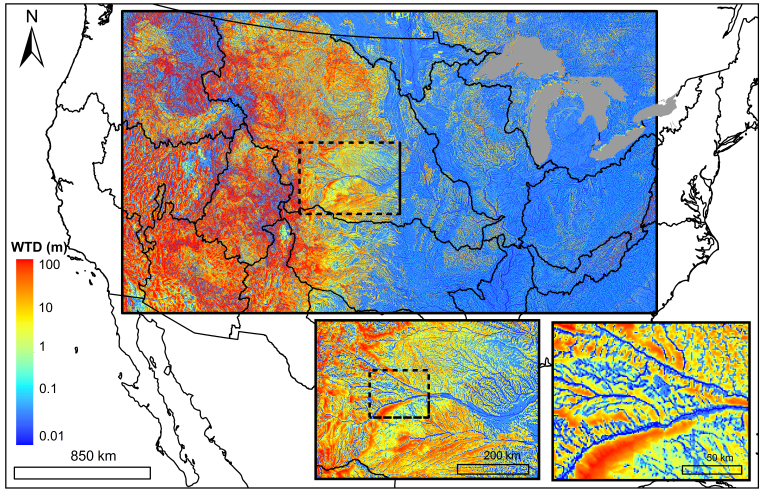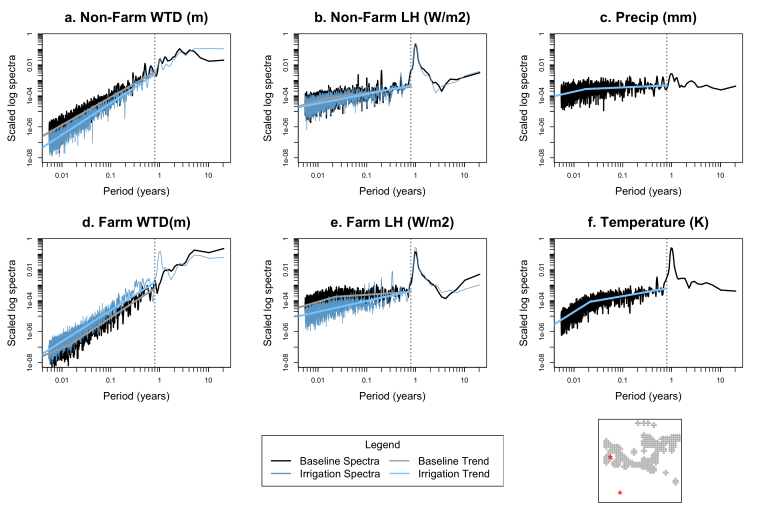My research is focused on large-scale water sustainability and the dynamic behavior of managed hydrologic systems in the context of past development and future climate change. Studies have demonstrated connections between groundwater depth, soil moisture, land energy fluxes and large-scale weather patterns; yet few have considered the effect management has on these interactions. Improved characterization of complex system dynamics could provide new avenues for increasing efficiency and mitigating risk. My work combines physically based numerical modeling with statistical techniques to evaluate large systems using rigorous quantitative methods. Some examples of my recent and ongoing projects are listed below.
Continental scale modeling

Simulated Water Table Depths (Maxwell et al., 2015)
I am part of a team that built the first high resolution, fully integrated, groundwater surface water model of the Continental US (CONUS) through the DOE IDEAS project. Outputs from the CONUS simulations provide a unique opportunity to explicitly analyze groundwater behavior at a level of detail and complexity not possible with analytical or observational approaches. Already model outputs have been used to characterize the importance of topography as a driver of groundwater configuration, quantify groundwater controls using a novel spatial regression algorithm and evaluate groundwater residence times using a Lagrangian particle tracking approach. Simulations of this scale are a significant computational undertaking that require high performance computing resources and generate terabytes of output. Current work is focused on improving model performance and data handling, developing transient simulations and incorporating large-scale water management into predevelopment simulations.
Evaluating the role of water management within integrated physical systems

Temporal scaling analysis of Water Table Depth (WTD), Latent Heat Flux (LH) , precipitation and temperature (Condon and Maxwell, 2014)
My doctoral research focused on characterizing the impact of regional to continental scale water management on physical interactions within the hydrologic cycle. I developed a water allocation module, which I coupled to the integrated physical hydrology model ParFlow. This coupling facilitates the simulation of water management operations (in this case groundwater pumping) that respond dynamically to the state of the physical system. Using this framework, I simulated twenty years of moisture dependent groundwater fed irrigation in the Little Washita basin in southwestern Oklahoma. I applied scaling and frequency analysis techniques to quantify feedbacks between groundwater pumping and irrigation demand as well as the impact of groundwater fed irrigation on temporal memory and spatial organization. Results show that within a critical groundwater depth range, soil moisture, and therefore irrigation demand, are sensitive to groundwater depth. Thus, groundwater pumping, even in adjacent areas, can cause some farms to transition from periodic pumping to escalating demand. With these results, we also demonstrated that pumping and irrigation increase the temporal memory of both the surface and subsurface and can fundamentally alter temporal groundwater fluctuations.
Climate change analysis and water resources planning

Non-stationary flood risk projections (Condon et al., 2015)
I have significant experience working with water managers to plan for climate change. I have worked on numerous projects using stochastic methods to assess climate teleconnections, improve seasonal forecasting for reservoir management and evaluate non-stationary flood risk. As a hydrologist for the Bureau of Reclamation, I worked on several regional planning studies, incorporating downscaled climate projections into hydrologic and decision support models to assess vulnerability. I have had the opportunity to collaborate with water managers at many levels and have experienced first-hand the potential for and the challenges of incorporating hydrologic science into decision-making. I’m interested in developing research projects to connect hydrologic studies to resource planning, risk assessment, infrastructure development and policy.
